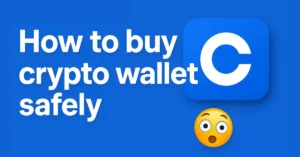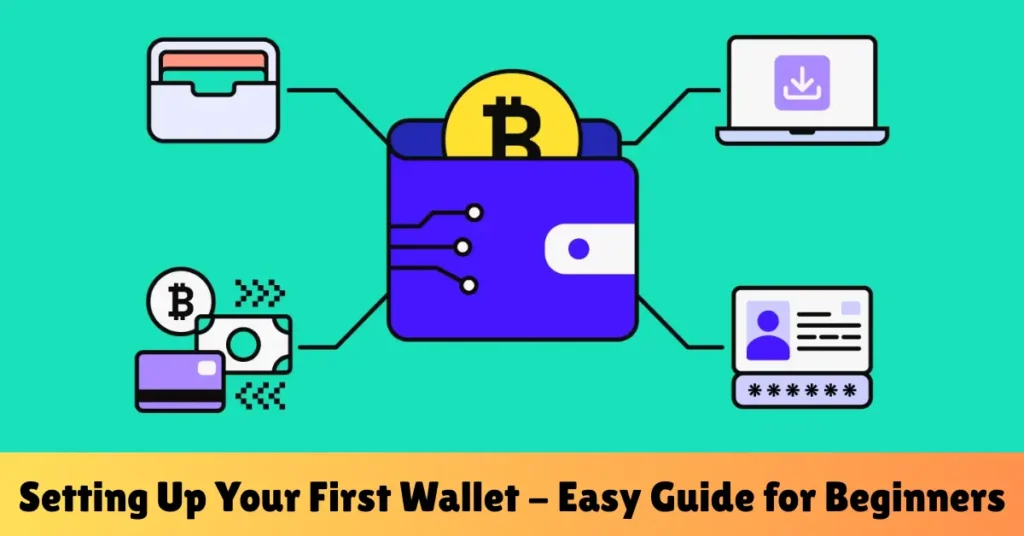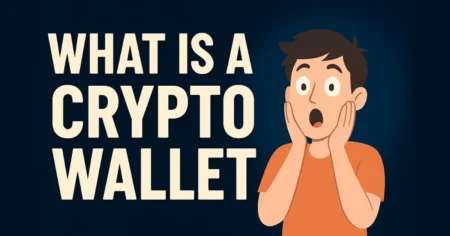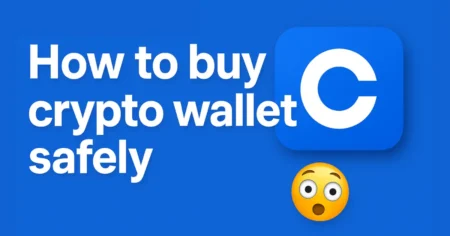Introduction
If you’re new to cryptocurrency, one of the first things you’ll hear about is a “wallet.” But don’t worry — it’s not the kind of wallet you carry in your pocket. A crypto wallet is a tool that allows you to store, send, and receive digital currencies like Bitcoin, Ethereum, and many others.
Setting up your first wallet might sound technical, but it’s much easier than most people think. Whether you want to invest, trade, or explore the crypto space, having your own wallet gives you full control over your digital money.
In this guide, we’ll walk you through what a crypto wallet is, the different types available, and how you can set one up step by step. By the end, you’ll have a clear understanding of how to get started safely and confidently in the world of crypto.
What is a Crypto Wallet?

A crypto wallet is a digital tool that allows you to store, send, and receive cryptocurrencies like Bitcoin, Ethereum, and many others. Just like a regular wallet holds your cash and cards, a crypto wallet holds your private keys, which are like passwords that give you access to your digital assets.
It’s important to know that crypto wallets don’t store your coins inside them. Your cryptocurrencies live on the blockchain — a global digital ledger — and the wallet simply gives you access to them by using those private keys.
There are two main types of crypto wallets:
- Custodial Wallets: These are wallets where a third party (like an exchange) manages your keys for you. They’re easy to use and great for beginners, but you don’t have full control over your assets.
- Non-Custodial Wallets: These wallets give you full control of your private keys. No one else can access your funds, but it also means you’re responsible for keeping your keys safe.
In short, a crypto wallet is your gateway to the world of digital money. Whether you’re buying your first coin or already exploring the crypto space, having a wallet is the first step to becoming your bank.
Different Types of Wallets
When setting up your first crypto wallet, it’s important to know that not all wallets are the same. Each type offers different levels of security, convenience, and control. Let’s take a look at the most common types of wallets so you can choose the one that suits you best.
Hardware Wallets
These are physical devices (like a USB drive) that store your crypto offline. They are one of the safest options because they are not connected to the internet, which makes them very hard to hack.
- Best for: Long-term holders and people who want top-level security.
- Examples: Ledger Nano S, Trezor.
Software Wallets
These wallets are apps or programs you install on your computer or mobile phone. They’re easy to use and good for everyday transactions.
- Desktop Wallets: Installed on your PC or laptop.
- Mobile Wallets: Apps on your smartphone for quick access.
- Web Wallets: Accessed through a web browser. These are convenient but often less secure.
- Best for: Beginners and people who want quick and easy access to their crypto.
Examples: MetaMask, Trust Wallet, Exodus.
Paper Wallets
A paper wallet is a printed piece of paper that contains your public and private keys. It’s stored offline, making it immune to online hacks, but it’s also easy to damage or lose.
- Best for: Advanced users who want a cold storage method.
- Note: Not commonly used today due to more secure and user-friendly alternatives.
Quick Comparison Table
| Wallet Type | Security | Ease of Use | Internet Connection | Best For |
| Hardware Wallet | Very High | Medium | No | Long-term, high-security use |
| Software Wallet | Medium | High | Yes | Daily use, beginners |
| Paper Wallet | High | Low | No | Offline storage experts |
Each wallet type has its strengths and weaknesses. The right choice depends on how often you plan to use crypto and how much security you need.
Choosing the Right Wallet for You
With so many wallet options out there, it can feel a bit overwhelming to pick the right one. But don’t worry choosing a wallet becomes easy once you understand your own needs.
Here are a few important things to consider when selecting your first crypto wallet:
Security
Ask yourself: How important is security to you?
If you’re planning to store a large amount of crypto for a long time, a hardware wallet (like Ledger or Trezor) is a smart choice. It keeps your funds offline and safe from online attacks.
For smaller amounts or frequent transactions, a software wallet (like MetaMask or Trust Wallet) is easier and still provides decent security.
Ease of Use
If you’re new to crypto, you’ll want a wallet that’s simple and beginner-friendly. Many mobile wallets have user-friendly designs, easy setup, and helpful guides built in.
Supported Coins
Not all wallets support every cryptocurrency. Make sure the wallet you choose supports the specific coins or tokens you plan to use.
Accessibility
Think about how often you’ll need access to your crypto:
- Use a mobile wallet if you want to access your funds on the go.
- A desktop or web wallet might be better for managing funds from home.
- A hardware wallet is best for long-term storage, not daily use.
Control Over Your Funds
- If you want to have full control of your crypto, go for a non-custodial wallet — this means only you hold the keys to your funds.
- Avoid wallets or exchanges that keep your keys, unless you’re okay with trusting them.
Popular Wallets for Beginners
Here are a few well-known and trusted wallets that are great for getting started:
- MetaMask (Browser/mobile wallet for Ethereum and other tokens)
- Trust Wallet (a Mobile wallet that supports many coins)
- Exodus (User-friendly desktop and mobile wallet)
- Ledger Nano S/X (Highly secure hardware wallet)
Take your time, do some research, and choose the wallet that matches your needs. The most important thing is to start safely and understand how to protect your digital money.
Step-by-Step: How to Set Up Your First Wallet
Setting up your first crypto wallet might sound complicated, but it’s very straightforward. Just follow these easy steps, and you’ll be ready to manage your digital assets in no time.
Step 1: Choose the Right Wallet
First, pick the type of wallet that fits your needs (hardware, mobile, desktop, or web). For beginners, a mobile wallet like Trust Wallet or a browser wallet like MetaMask is a great starting point.
Step 2: Download or Purchase the Wallet
- If it’s a software wallet, go to the official website or app store and download it.
- If it’s a hardware wallet, order it directly from the official site to avoid scams or tampered devices.
Important: Always double-check that you’re downloading the official version of the wallet.
Step 3: Create a New Wallet
- Open the app or device and choose the “Create New Wallet” option.
- You may be asked to set up a password. Make sure it’s strong and unique.
Step 4: Write Down Your Recovery Phrase
You’ll be shown a list of 12 to 24 random words — this is your recovery phrase (also called a seed phrase).
- This phrase is the only way to recover your wallet if you lose your phone or device.
- Write it down on paper (not on your phone or computer) and keep it in a safe, private place.
Never share your recovery phrase with anyone. If someone gets access to it, they can steal your crypto.
Step 5: Confirm Your Recovery Phrase
To make sure you’ve saved it correctly, the wallet will ask you to enter the words in the right order. This step helps confirm that you’ve backed up your wallet properly.
Step 6: Explore the Wallet Features
Once your wallet is set up, take a moment to get familiar with its features:
- Check your wallet address (used to receive crypto)
- View your balance (even if it’s zero for now)
- Explore options to send, receive, and add tokens
Now your wallet is ready to use! In the next section, we’ll look at how to use your wallet, from sending and receiving crypto to tracking your assets.
How to Use Your Wallet

Once your wallet is set up, it’s time to start using it. Whether you want to send crypto, receive it, or just check your balance, using your wallet is pretty straightforward. Here’s how it works:
Receiving Crypto
If someone wants to send you cryptocurrency, you’ll need to give them your wallet address.
- Open your wallet and find the “Receive” option.
- You’ll see a long string of letters and numbers — this is your public address.
- You can also use a QR code for quick scanning.
Tip: Always double-check your address before sharing it. Each wallet has a unique address for each coin, so make sure you’re giving the right one (for example, don’t send Ethereum to a Bitcoin address).
Sending Crypto
When you want to send crypto to someone else:
- Tap or click on “Send” in your wallet.
- Paste the recipient’s wallet address.
- Enter the amount you want to send.
- Choose the network fee (some wallets let you adjust this — faster transactions cost more).
- Confirm and approve the transaction.
Once sent, you can usually track the progress of your transaction on a blockchain explorer (your wallet may provide a link).
Checking Your Balance
Your wallet will show your current balance and the value of your crypto. Some wallets also show this in your local currency for easy understanding.
You can also view your transaction history to keep track of what you’ve sent and received.
Managing Multiple Cryptocurrencies
Most wallets support multiple coins and tokens. You can add or hide them based on what you’re using.
For example:
- In Trust Wallet, you can enable or disable different coins from the main screen.
- In MetaMask, you can import tokens manually by entering their contract address.
Quick Tips
- Only send crypto to the correct type of address (e.g., send BTC to a Bitcoin address).
- Double-check every detail before confirming a transaction.
- Keep a small test transaction if you’re sending a large amount for the first time.
Using your wallet becomes second nature with a little practice. Next, let’s look at some important safety tips to help protect your crypto.
Wallet Safety Tips for Beginners
Your crypto wallet gives you full control over your digital money, but with that control comes responsibility. Since most crypto transactions are irreversible, it’s important to protect your wallet from mistakes, hacks, and scams.
Here are some essential safety tips every beginner should follow:
Keep Your Recovery Phrase Safe
Your recovery phrase (also called a seed phrase) is the key to your wallet. Anyone who has it can access your funds.
- Write it down on paper — never save it on your phone or computer.
- Store it in a safe place (ideally offline, and even better in multiple secure locations).
- Never share it with anyone, no matter who asks.
Use Official Sources Only
Always download wallets from their official websites or trusted app stores.
- Avoid clicking on wallet links from social media, ads, or unknown emails.
- Double-check URLs before entering any sensitive information.
Set a Strong Password
- Choose a strong and unique password for your wallet. Don’t reuse passwords from other accounts.
- If your wallet supports two-factor authentication (2FA), enable it for an extra layer of security.
Watch Out for Phishing Scams
Scammers often create fake websites or apps that look like real wallets to steal your information.
- Be cautious of emails or messages asking you to “verify your wallet” or “unlock your account.”
- Always check the sender and avoid clicking on suspicious links.
Double-Check Before Sending
Before you send crypto:
- Confirm the recipient’s address.
- Make sure you’re using the correct network.
- If it’s a large amount, consider sending a small test transaction first.
Once sent, crypto transactions can’t be reversed — so it’s better to be safe.
Update Your Wallet Regularly
If you’re using a software wallet, keep it updated to the latest version. Updates often include important security patches and performance improvements.
Don’t Share Wallet Info Publicly
Even sharing your wallet address publicly (like on social media) can make you a target for scams and spam. Only share it when you need to receive funds.
By following these safety tips, you can protect your digital assets and enjoy the benefits of crypto with more peace of mind.
Common Mistakes to Avoid
When setting up and using a crypto wallet for the first time, it’s easy to make mistakes, especially if you’re new to how everything works. Learning about these common errors can help you avoid them and protect your funds.
Losing Your Recovery Phrase
This is the biggest mistake new users make. If you lose your recovery phrase and something happens to your device, you will not be able to access your crypto.
Avoid it by:
- Write down your seed phrase on paper.
- Keeping it stored in a safe and private place.
- Never relying on screenshots or digital notes.
Using Fake or Unofficial Wallets
Some people accidentally download fake wallet apps or visit scam websites that look like real ones.
Avoid it by:
- Always downloading from official sources.
- Bookmarking the official website for future use.
Sending Crypto to the Wrong Address
Crypto transactions are one-way and irreversible. If you send funds to the wrong address or the wrong type of wallet (e.g., sending Bitcoin to an Ethereum address), you may lose them permanently.
Avoid it by:
- Double-check the wallet address before every transaction.
- Making small test transfers first, especially with large amounts.
Ignoring Network Fees
Every crypto transaction requires a network fee. Some beginners try to set the fee too low to save money, which can cause their transactions to get stuck or delayed.
Avoid it by:
- Using the recommended fee suggested by your wallet.
- Learning a bit about how network fees work for different blockchains.
Storing Everything Online
Keeping your recovery phrase or passwords in cloud storage, email, or notepad files can be risky. Hackers and malware can find them easily.
Avoid it by:
- Keeping sensitive info offline.
- Using a hardware wallet if you’re storing a large amount of crypto.
Not Updating Your Wallet Software
Old versions of wallet apps may have bugs or security vulnerabilities.
Avoid it by:
- Regularly update your wallet software to the latest version.
- Enabling notifications for updates, if available.
Trusting Strangers or Online “Helpers”
Some scammers pose as support agents or friendly experts and ask for your recovery phrase or to “fix” your wallet.
Avoid it by:
- Never share your private info with anyone.
- Knowing that real wallet providers will never ask for your recovery phrase.
Avoiding these common mistakes can save you from losing your funds or falling victim to scams. Learning and staying cautious is the key to becoming confident in your crypto journey.
Conclusion
Setting up your first crypto wallet is a big step into the world of digital finance. While it might seem technical at first, it’s actually quite simple once you understand the basics.
By choosing the right type of wallet, learning how to use it safely, and avoiding common mistakes, you can take full control of your cryptocurrency. Whether you’re holding, trading, or just exploring, your wallet is the foundation of your crypto journey.
Always remember: your crypto is only as safe as the steps you take to protect it. Take time to secure your wallet, keep your recovery phrase private, and stay informed.
Now that you know how to set up and use a wallet confidently, you’re well on your way to becoming a smart and responsible crypto user.
Also read
- What is a Crypto Wallet and How Does It Work? – Coinsify
- 10 Crypto Terms Every Beginner Must Know – Coinsify
- What is Blockchain Technology – Complete Guide – Coinsify
- How to Buy Crypto Safely in 2025 – Complete Guide – Coinsify
- Bitcoin vs Ethereum: Key Differences Explained – Complete Guide
- Ultimate Blockchain Glossary: Learn Blockchain Terms Easily
- How to Buy Bitcoin Safely (Complete Beginner’s Guide)
- Top 10 Crypto Wallets for Beginners (2025 Edition)
- What is Cryptocurrency? A Beginner-Friendly Guide (2025)






